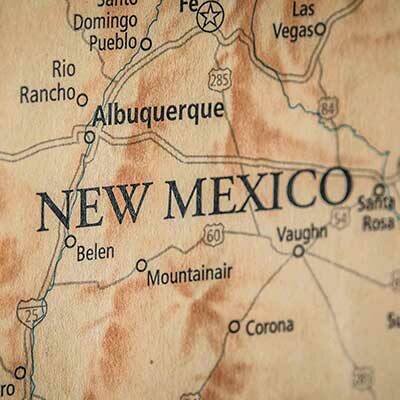Blaming Superfund, Air Force keeps punting on PFAS cleanup
Laura Paskus
October 6, 2021
Last month, the U.S. Air Force held one of its quarterly meetings related to PFAS contamination from Cannon Air Force Base in Clovis, New Mexico.
Officials talked about an upcoming pilot program, a $16.6 million water treatment plant at the southeastern corner of the base that would test ways to remove the toxic chemicals from groundwater. That facility is slated to begin operations in 2023 and will “pump and treat” water only from below the base itself.
The meeting, which you can watch on the NMPBS YouTube page, included the base's new commander, Col. Terence G. Taylor. He repeated the words of previous commanders, noting he, too, lives on the base and cares about clean water.
But nearby residents seem increasingly concerned, now more than three years after learning the military contaminated water with “forever chemicals.”
In 2018, the Air Force notified state officials and local well-owners that its use of certain firefighting foams had polluted groundwater with PFAS, or per- and polyfluoroalkyl substances.
Since then, the Air Force has yet to map the full extent of the contamination or begin cleanup.
Although the U.S. Environmental Protection Agency set a lifetime health “advisory” for the chemicals at 70 parts per trillion, the federal agency has not set a regulatory standard for drinking water.
Without that, states like New Mexico can’t mandate cleanup. When New Mexico state officials tried to order the Air Force to clean up PFAS pollution from Cannon and Holloman Air Force Base, the military sued, challenging the state’s authority.
Despite assurances from Air Force officials that the U.S. Department of Defense is doing all it can, during the meeting’s Q&A session some people expressed dissatisfaction with response to the pollution, which has spread off-base to private wells, including those that supply homes and dairies.
In addition, John Kern, executive director of Clean Water Partnership - Cannon, requested that Taylor visit with the off-base community and see their challenges firsthand—an invitation previous commanders have not accepted.
Throughout the meeting, as well as during interviews, Air Force officials have indicated their hands are tied when it comes to cleanup, blaming the federal Superfund process, or CERCLA, the Comprehensive Environmental Response, Compensation, and Liability Act.
Framing the issue that way, and not acknowledging the lawsuits between the military and the state, has been a useful way to deflect responsibility for a speedy cleanup—and presumably also inspired the Albuquerque Journal to cover the quarterly meeting as it did, with a headline that read, “Cannon AFB tries to speed cleanup.”
In other PFAS news
In Barnstable, Massachusetts, PFAS was found in all 21 ponds tested for the chemicals. For the Cape Cod Times, Jeanette Hinkle reported:
When [Tom] Cambareri compared PFAS levels in the surface water bodies he sampled to PFAS levels in Hyannis’s public drinking wells before treatment, he confirmed that contamination in ponds, lakes and creeks was correlated with contamination in village wells.
Manufactures like DuPont and 3M knew that exposure to PFAS caused health problems in animals and humans decades ago, yet continued to make, market, and sell products anyway. Now, a story from Jim Spencer in the Star Tribune shows how expensive those choices have been—especially for taxpayers:
The failure of 3M and other manufacturers, such as DuPont, to publicly report and deal with potential PFAS problems when they first learned of them is saddling the companies with mounting legal costs because of lawsuits brought by several states and individuals. And it's about to cost U.S. taxpayers billions of dollars.
3M told the Star Tribune that it has paid "more than $1.2 billion" to treat PFAS pollution. That is a fraction of the $10 billion in taxpayer funds the country's new bipartisan infrastructure bill allocates for PFAS cleanup. Other proposed PFAS pollution bills in Congress allocate billions more to clean up a mess 3M and other corporations made.
The Allegheny Front has an interesting Q&A with reporter Kristina Marusic about why it’s taking Pennsylvania so long to regulate PFAS even though the state’s Environmental Quality Board voted in June to set a Maximum Contaminant Level for PFAS in drinking water.
Kelly Kenoyer with WHQR reports that the Biden administration’s EPA has agreed to reconsider a petition that would require Chemours to investigate how its releases of PFAS into the Cape Fear River in North Carolina have affected public health. As she reported:
While Chemours has faced new regulations since its dumping was publicized in 2017, there are still higher levels of PFAS in the Cape Fear River than in almost any other part of the country. And PFAS are still not yet officially regulated by the EPA or the state’s Department of Environmental Quality.
But this week, the EPA agreed to reconsider a petition which would force Chemours to pay for health studies of some of the newer PFAS compounds the company releases into the river. The petition was denied under the Trump administration in January, but will now be reconsidered under Secretary Michael Regan’s administration within 90 days.
On Last Week Tonight, John Oliver leant high-profile attention to PFAS and the role manufactures like DuPont and 3M have played in knowingly polluting the environment and sickening workers and others. Mixing old advertisements, congressional testimony, news reporting, and scientific data with profanity-laden outrage and a skit from Danny DeVito, Oliver laid out the problems PFAS cause and how hard it is to hold polluters accountable, especially given how widespread contamination now is around the globe.
If you’ve been affected by PFAS contamination in your community here in New Mexico, call our tip line at (505) 433-7242. To read more coverage of PFAS in New Mexico visit “Groundwater War: New Mexico’s Toxic Threat,” which includes a timeline of events and studies on PFAS.






